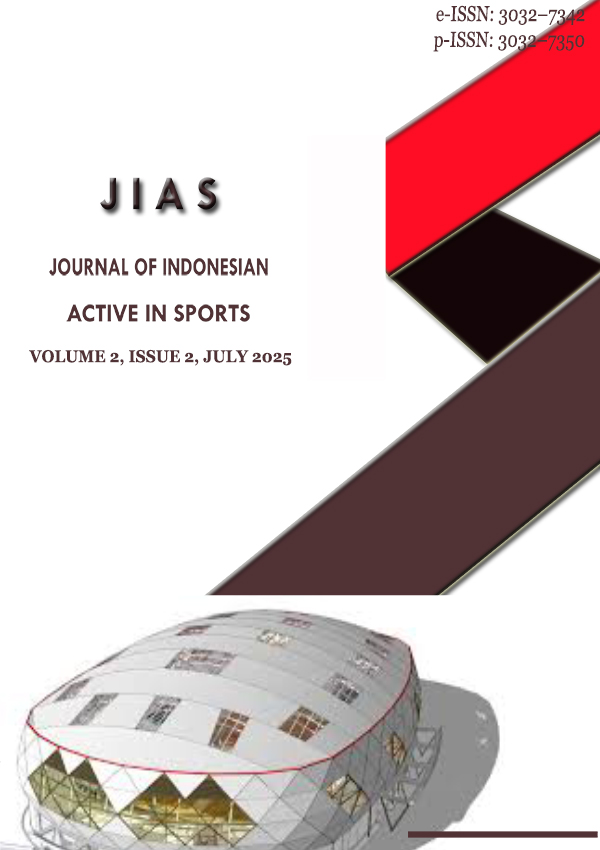Enhancing Passing Accuracy in Youth Soccer Players Through Paired Passing Drills
DOI:
https://doi.org/10.24114/jias.v2i2.64531Abstrak
Passing accuracy is a fundamental skill in soccer, enabling teams to maintain possession, create offensive plays, and control the game’s tempo. However, young athletes often struggle with passing precision due to monotonous training methods and limited exposure to varied drills. This study aims to examine the effects of paired passing variation training on the passing accuracy of soccer players aged 10–12 years at Siborong-Borong United Soccer School. The study employed an experimental design using pre-test and post-test assessments to measure passing ability before and after a four-week intervention. The total population of 14 athletes was used as the research sample through total sampling. Data collection was conducted using a standardized soccer skill assessment test, and statistical analysis was performed using paired sample t-tests. The results revealed a significant improvement in passing accuracy following the intervention. The mean passing score increased from 8.07 (pre-test) to 13.57 (post-test), with a mean difference of 5.64 points, demonstrating a statistically significant enhancement (t = 7.05, p < 0.05). These findings indicate that structured paired passing drills effectively improve passing accuracy by reinforcing muscle memory, ball control, and decision-making under match-like conditions. This study contributes to sports training methodologies by emphasizing the importance of interactive and varied training approaches for young soccer players. Future research should explore the long-term retention of passing skills and the integration of tactical decision-making exercises to maximize skill transferability in competitive matches.Referensi
Ali, A., Williams, C., Hulse, M., Strudwick, A., Reddin, J., Howarth, L., . . . McGregor, S. (2007). Reliability and validity of two tests of soccer skill. Journal of sports sciences, 25(13), 1461-1470. doi:https://doi.org/10.1080/02640410601150470
Burgos Angulo, D. J., Sánchez Jiménez, K. A., Feraud Cañizares, R. A., Perlaza Estupiñán, A. A., Coello Castro, M. A., & Morales Fischer, B. R. (2024). Entrenamiento físico/técnico/táctico vs entrenamiento físico: efectos en la resistencia/velocidad de futbolistas prejuveniles (Physical/technical/tactical training vs physical training: Effects on resistance/speed of youth soccer players). Retos, 60, 1084-1092. doi:https://doi.org/10.47197/retos.v60.107980
Clemente, F. M., Silva, A. F., Alves, A. R., Nikolaidis, P. T., Ramirez-Campillo, R., Lima, R., . . . Knechtle, B. (2020). Variations of estimated maximal aerobic speed in children soccer players and its associations with the accumulated training load: Comparisons between non, low and high responders. Physiology & Behavior, 224, 113030. doi:https://doi.org/10.1016/j.physbeh.2020.113030
Doewes, R. I., Purnama, S., Syaifullah, R., & Nuryadin, I. (2020). The effect of small sided games training method on football basic skills of dribbling and passing in indonesian players aged 10-12 years. Int J Adv Sci Technol, 29(3), 429-441.
Duncan, M. J., Clarke, N. D., Bolt, L., Eyre, E., & Roscoe, C. M. P. (2022). Fundamental Movement Skills and Physical Fitness Are Key Correlates of Tactical Soccer Skill in Grassroots Soccer Players Aged 8–14 Years. Journal of Motor Learning and Development, 10(2), 290-308. doi:https://doi.org/10.1123/jmld.2021-0061
Egan, C. D., Verheul, M. H. G., & Savelsbergh, G. J. P. (2007). Effects of Experience on the Coordination of Internally and Externally Timed Soccer Kicks. Journal of Motor Behavior, 39(5), 423-432. doi:https://doi.org/10.3200/JMBR.39.5.423-432
Field, A. (2013). Discovering Statistics Using IBM SPSS Statistics (4 ed.). Thousand Oaks: Sage.
Ford, P. R., Yates, I., & Williams, A. M. (2010). An analysis of practice activities and instructional behaviours used by youth soccer coaches during practice: Exploring the link between science and application. Journal of sports sciences, 28(5), 483-495. doi:https://doi.org/10.1080/02640410903582750
Marsuna, M., Rusli, M., & Saman, A. (2024). Improved passing accuracy by using pair practice in adolescent soccer players. Jurnal SPORTIF : Jurnal Penelitian Pembelajaran, 10(1), 31-46. doi:https://doi.org/10.29407/js_unpgri.v10i1.21732
Merlin, M., Pinto, A., Moura, F. A., Torres, R. d. S., & Cunha, S. A. (2024). Who are the best passing players in professional soccer? A machine learning approach for classifying passes with different levels of difficulty and discriminating the best passing players. PLOS ONE, 19(5), e0304139. doi:https://doi.org/10.1371/journal.pone.0304139
Nusri, A. (2018). Tes Keterampilan Sepakbola. Semarang: Cipta Prima Nusantara.
Panji, D. P. R., Moch, Y., Prisca, W., & Imam, H. (2024). Pengaruh Latihan Passing Berpasangan terhadap Kemampuan Passing Bawah SSB Kharisma Elang Muda U12 Malang. JOKER (Jurnal Ilmu Keolahragaan), 5(2), 355-364.
Papastaikoudis, F., Collins, R., & Collins, D. (2024). Bouncing back: a longitudinal examination of challenge within football academy environments. Frontiers in Sports and Active Living, 6, 1402570. doi:https://doi.org/10.3389/fspor.2024.1402570
Rein, R., Raabe, D., & Memmert, D. (2017). “Which pass is better?” Novel approaches to assess passing effectiveness in elite soccer. Human Movement Science, 55, 172-181. doi:https://doi.org/10.1016/j.humov.2017.07.010
Rumaropen, P. M., Harmaman, & Anwar, S. (2025). The Effect of Variation Training on Improving Passing Ability in the UKM Futsal Games for Girls UNIMUDA Sorong. JURNAL MUARA OLAHRAGA, 7(1), 300-311. doi:https://doi.org/10.52060/jmo.v7i1.2645
Saputra, M. S., Dewi, C., & Perdima, F. E. (2022). Pengaruh Latihan Passing Berpasangan dalam Permainan Sepak Bola di Klub Puma FC Desa Marga Bakti Kecamatan Pinang Raya Kabupaten Bengkulu Utara. Educative Sportive, 3(2), 91-98. doi:https://doi.org/10.33258/edusport.v3i02.2400
Schmidt, R., & Lee, T. (2014). Motor learning and performance: From principles to application (5 ed.). Champaign: Human Kinetics.
Sugiyono. (2017). Metode Penelitian Pendidikan: Pendekatan Kuantitatif, Kualitatif, dan R&D. Bandung: CV. Alfabeta.
Williams, A. M., & Reilly, T. (2000). Talent identification and development in soccer. Journal of sports sciences, 18(9), 657-667. doi:https://doi.org/10.1080/02640410050120041
Unduhan
Diterbitkan
Cara Mengutip
Terbitan
Bagian
Lisensi
Hak Cipta (c) 2025 Mikael Pasaribu, Zulfan Heri

Artikel ini berlisensiCreative Commons Attribution-ShareAlike 4.0 International License.












